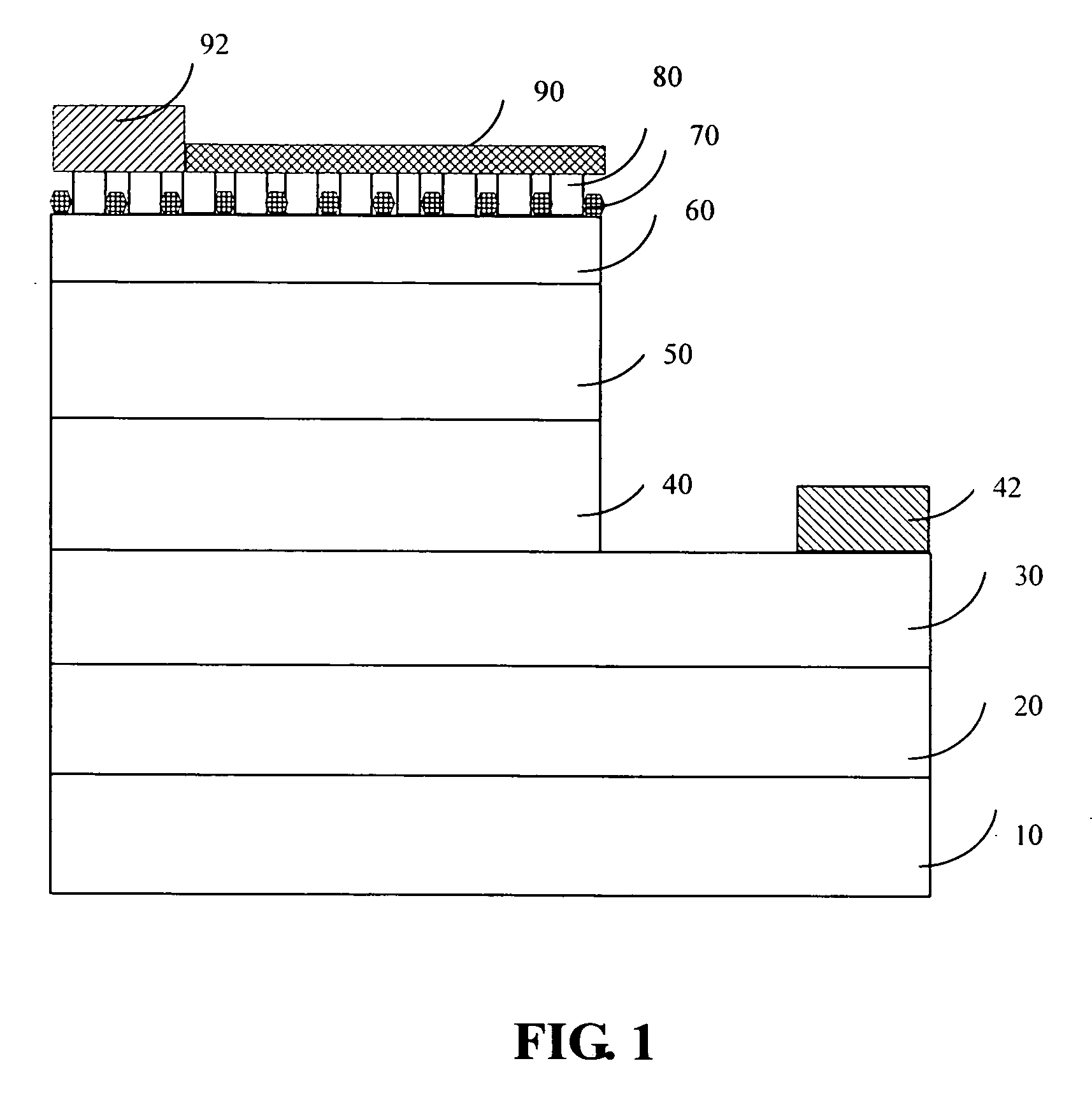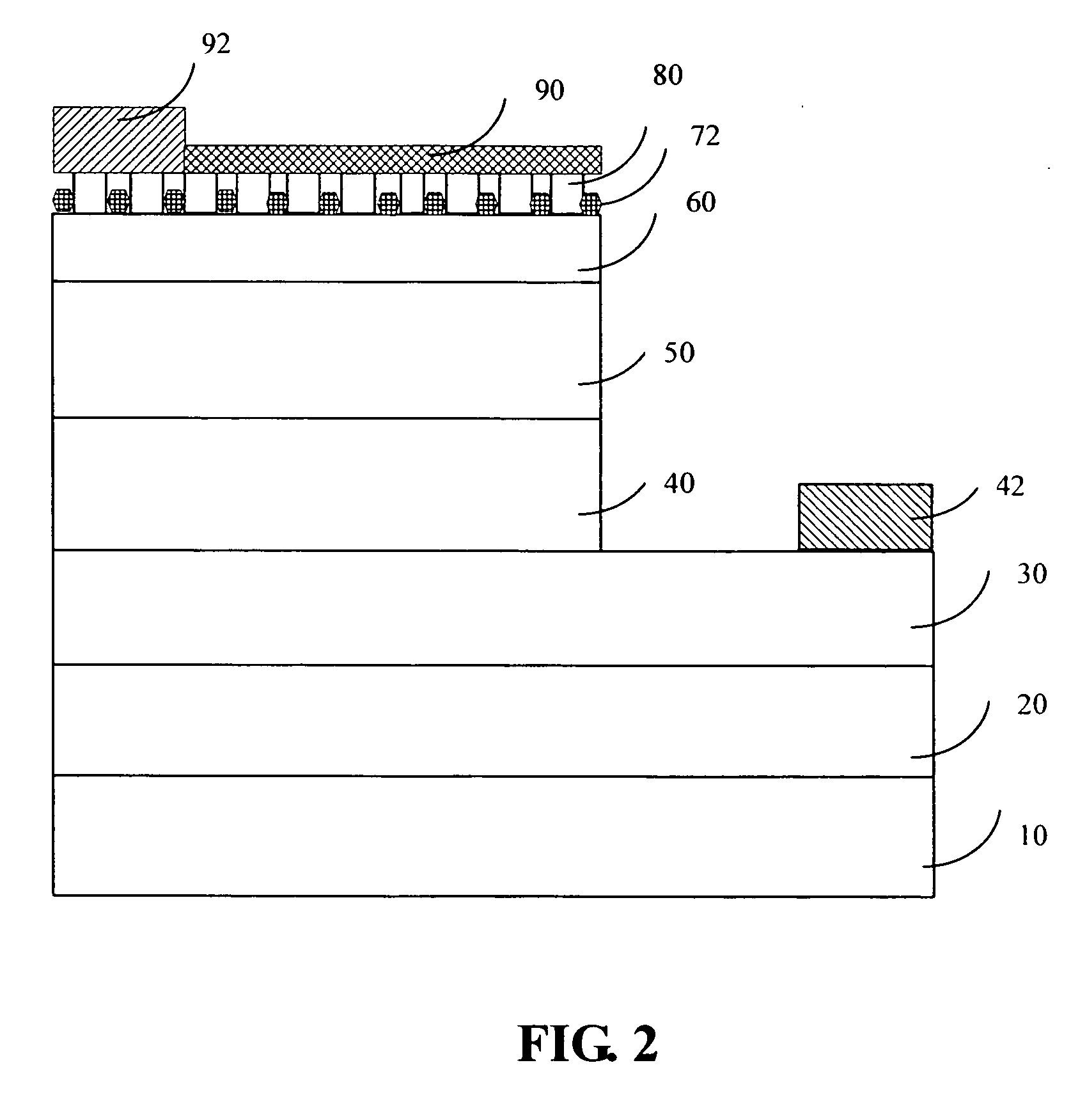High-brightness gallium-nitride based light emitting diode structure
a light-emitting diode, high-bright technology, applied in the direction of basic electric elements, electrical equipment, semiconductor devices, etc., can solve the problem of reducing the external quantum efficiency
- Summary
- Abstract
- Description
- Claims
- Application Information
AI Technical Summary
Benefits of technology
Problems solved by technology
Method used
Image
Examples
first embodiment
[0017]FIG. 1 is a schematic diagram showing a high-brightness GaN-based LED device according to the present invention. As shown in FIG. 1, the GaN-based LED device has a substrate 10 made of C-plane, R-plane, or A-plane aluminum-oxide monocrystalline (sapphire), or an oxide monocrystalline having a lattice constant compatible with that of nitride semiconductors. The substrate 10 can also be made of SiC (6H—SiC or 4H—SiC), Si, ZnO, GaAs, or MgAl2O4. Generally, the most common material used for the substrate 10 is sapphire or SiC. An optional buffer layer 20 made of a GaN-based material whose molecular formula could be expressed as AlaGabIn1-a-bN (0≦a,b10. On top of the buffer layer 20, a first contact layer 30 is formed and made of a GaN-based material having a first conduction type (e.g., it could be a p-typed GaN or n-typed GaN). Then, on top of the first contact layer 30, an active layer 40 made of a GaN-based material such as indium-gallium-nitride (InGaN) is formed on top of the...
second embodiment
[0022]FIG. 2 is a schematic diagram showing a high-brightness GaN-based LED device according to the present invention. As shown in FIG. 2, the present embodiment has an identical structure as in the previous embodiment. The only difference lies in the material used for the masking buffer layer. In the present embodiment, the masking buffer layer 72 is developed also by a MOCVD process using a group-II nitride MggNh (g,h≧1) having a specific composition. The masking buffer layer 72 has a thickness between 5 Å and 100 Å and is formed at a growing temperature between 600° C. and 1100° C. Similarly, the masking buffer layer 72 thus formed contains multiple randomly distributed clusters of MggNh on top of the second contact layer 60.
third embodiment
[0023]FIG. 3 is a schematic diagram showing a high-brightness GaN-based LED device according to the present invention. As shown in FIG. 3, the present embodiment has an identical structure as in the previous embodiments. The only difference lies in the material used for the masking buffer layer. In the present embodiment, the masking buffer layer 74 is developed also by a MOCVD process using a heavily doped group-III nitride AlkInlGa1-k-lN (0≦k,lkInlGa1-k-lN is doped with at least a dopant selected from the group-II and group-IV elements. For example, the dopant used could be Si, Mg, or both Si and Mg could be used. The doping density is at least 1×1020 cm−3. The masking buffer layer 74 has a thickness between 5 Å and 100 Å and is formed at a growing temperature between 600° C. and 1100° C. Similarly, the masking buffer layer 74 thus formed contains multiple randomly distributed clusters of AlkInlGa1-k-lN on top of the second contact layer 60.
[0024] In aforementioned preferred embod...
PUM
 Login to View More
Login to View More Abstract
Description
Claims
Application Information
 Login to View More
Login to View More - R&D
- Intellectual Property
- Life Sciences
- Materials
- Tech Scout
- Unparalleled Data Quality
- Higher Quality Content
- 60% Fewer Hallucinations
Browse by: Latest US Patents, China's latest patents, Technical Efficacy Thesaurus, Application Domain, Technology Topic, Popular Technical Reports.
© 2025 PatSnap. All rights reserved.Legal|Privacy policy|Modern Slavery Act Transparency Statement|Sitemap|About US| Contact US: help@patsnap.com



